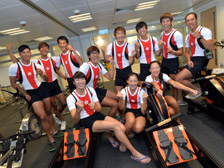
Well suited:
Hong Kong Rowing Team members model their tailor-made racing suits which are expected to give them an edge at the 2014 Asian Games in Incheon, South Korea next month.
Well suited:
Hong Kong Rowing Team members model their tailor-made racing suits which are expected to give them an edge at the 2014 Asian Games in Incheon, South Korea next month.
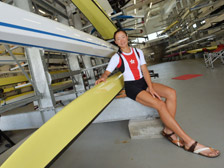
Golden goal:
Lee Ka-man will participate in the Asian Games for the fourth time, and has set her sights on not just another medal – but on the gold.
Golden goal:
Lee Ka-man will participate in the Asian Games for the fourth time, and has set her sights on not just another medal – but on the gold.
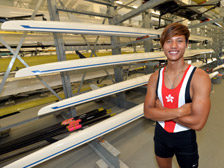
Psychological advantage:
Chow Kwong-wing is keen to see his rivals’ reaction to the team’s custom designed suits.
Psychological advantage:
Chow Kwong-wing is keen to see his rivals’ reaction to the team’s custom designed suits.
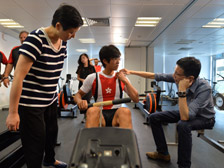
Attention to detail:
Several prototypes were made for fitting, adjustment and improvement before production of the final cutting-edge racing suits.
Attention to detail:
Several prototypes were made for fitting, adjustment and improvement before production of the final cutting-edge racing suits.
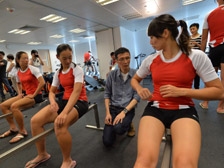
Raising standards:
Hong Kong Research Institute of Textiles & Apparel’s Chief Executive Officer Edwin Keh (second right) said the institute will share its research results and innovative technologies with the trades to enhance their competitiveness.
Raising standards:
Hong Kong Research Institute of Textiles & Apparel’s Chief Executive Officer Edwin Keh (second right) said the institute will share its research results and innovative technologies with the trades to enhance their competitiveness.
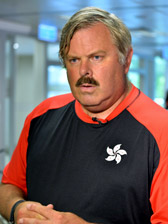
Sports science:
Hong Kong Rowing Team head coach Christopher Perry said the design of a rower’s suit must accommodate the athlete’s seated position and ensure free arm movement.
Sports science:
Hong Kong Rowing Team head coach Christopher Perry said the design of a rower’s suit must accommodate the athlete’s seated position and ensure free arm movement.
Custom suit bolsters paddle power
August 24, 2014
Clothes may not make the man, but a tailor-made racing suit could help make champions of the 10-member Hong Kong Rowing Team at the 2014 Asian Games in Incheon, South Korea next month.
The Hong Kong Research Institute of Textiles & Apparel and Hong Kong Polytechnic University’s Institute of Textiles & Clothing teamed up in February to develop the high-tech suit. The one-piece short and vest combination is ultra-thin, ultra-lightweight, breathable, and UV and wear-resistant.
To ensure a custom fit, each of the elite athletes underwent a three-dimensional scan that collected their precise measurements. The institutes developed several prototypes for fitting, adjustment and improvement before producing the finished cutting-edge racing suits.
Just before the team left for its final intensive pre-games training in Shandong, with climate similar to Incheon’s, the athletes had their final suit fittings at the Hong Kong Sports Institute. Their enthusiasm was palpable.
“This racing suit is tight but very flexible, I feel free and comfortable when I row,” said Lee Ka-man. It will be her fourth time competing in the Asian Games, having taken the silver medal in 2006 at Doha. This time, she’s competing in the women’s singles and lightweight singles and has set her sights on not just another medal – but on the gold.
She appreciates the suit’s form-fitting aspect, which she believes will give the team an edge.
“It shows off the athlete’s lean and fit figure, which makes us feel confident.”
Custom comfort
Team head coach Christopher Perry described the unique requirements of a suit designed for rowers that takes into account their seated position inside a boat.
“The rower has to use their whole body in a sitting position. They are sliding, using their arms, shoulders, legs, and their back is curved. So it's important that the rowing suit fits in that sitting and moving position. It's not about how the suit looks when you are standing up, but it’s about how the suit works when you are sitting down in the boat. So, having a specially designed suit is very different from buying one from the peg.
“Athletes are rowing hundreds of strokes in training and competition, and if the suits are uncomfortable, rubbing their skin, they can get very sore,” Mr Perry added.
Wearing uniform suits in Hong Kong colours that bear the Hong Kong emblem also has a positive psychological effect on team members.
“They feel like they are special and flying the Hong Kong flags,” he said.
Team commander, 28-year-old Chow Kwong-wing, won a silver medal at the 2010 Guangzhou Asian Games and will participate in the men’s lightweight double and lightweight quad in Incheon. He is looking forward to his rivals’ reaction to the new suit.
“The suit is very light. As we are lightweight athletes, even a weight as little as 100 grams is crucial to us. This racing suit weights 200 grams less than the previous one, which means we can eat up to 200 grams more, which is enough to boost our performance,” he said.
Mr Chow also appreciated the suit’s extra deep underarm cutaways that prevent chafing and allow freer movement, and the breathable material which helps perspiration escape to keep rowers cool.
Like Mr Perry, Mr Chow also considered the mental impact on other teams.
“I think when our opponents see us wearing such smart uniforms, we will have some psychological advantages.”
Mutual benefits
The research, design and production of the racing suits cost about $700,000, all funded by the Innovation & Technology Fund.
“At the high level of competition, weight and any minor competitive advantage can be the difference between the gold medal and the silver medal. So, it was crucial for us to keep the weight to a minimum,” Hong Kong Research Institute of Textiles & Apparel’s Chief Executive Officer Edwin Keh said.
The project not only provided a set of high performance racing suits for the rowing team, but also benefits the textiles and apparel industries in Hong Kong, Mr Keh said. His institute will share its research results and innovative technologies with the trades, to enhance the local textile industry’s competitiveness, also.
He looks forward to co-operating with the sports institute to design high-performance uniforms for other elite athletes taking part in international sports events.